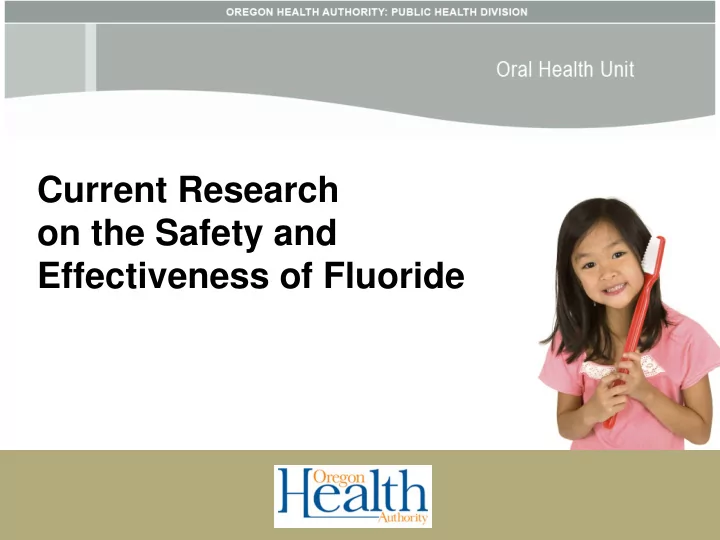

Current Research on the Safety and Effectiveness of Fluoride
For links to the research, please contact us and we will send you a document with operable links: Oregon Health Authority/Oral Health Unit Phone: 971-673-0235 Email: Oral.health@state.or.us Website: www.healthoregon.org/schooloralhealth
When children’s oral health suffers, so does their ability to learn… http://www.mchoralhealth.org/PDFs/learningfactsheet.pdf
Why is the School Fluoride Program so important in Oregon?
2017 Oregon Smile Survey results • Despite being preventable, tooth decay (cavities) remains a significant public health concern and causes needless pain and suffering for many of our children in Oregon. • Poor oral health can contribute to increased absenteeism, poor school performance, poor self-esteem and less success later in life. • About one in two children (49%) between 6-9 years of age have had a cavity, representing about 65,600 school children.
2017 Oregon Smile Survey (cont.) • Oregon now meets the Healthy People 2020 goal (49.0%) for tooth decay experience. However, there is much more progress to be made in preventing cavities. • Almost one in five children (19%) between 6-9 years of age had untreated cavities in their primary (baby) or permanent teeth. • More than 6,000 children had rampant cavities — seven or more teeth with fillings or untreated cavities.
2017 Oregon Smile Survey (cont.) • Oral health disparities exist for children based on geographic residence, household income, and race and ethnicity. • Children from counties in southeastern Oregon have had more cavities than the rest of the state. • Children from lower-income households had substantially more cavities compared to children from higher-income households (63% vs. 38%). • Hispanic/Latino children, compared to white children, are significantly more likely to have had fillings and untreated cavities.
Water Fluoridation Oregon currently ranks 48 out of 50 states in access to fluoridated water. Only Hawaii and New Jersey rank lower. Only about 22% of Oregonians have access to fluoridated water, compared to 74% of the rest of the U.S.
The Story of Fluoridation General information from the National Institute of Dental and Craniofacial Research (NICDR) about the origins of fluoride use to prevent tooth decay: The Story of Fluoridation https://www.nidcr.nih.gov/health-info/fluoride/the-story-of-fluoridation
Centers for Disease Control and Prevention (2013) “Nearly all naturally occurring water sources contain fluoride—a mineral that has been proven to prevent, and even reverse, tooth decay.” CDC: Water Fluoridation Basics https://www.cdc.gov/fluoridation/basics/index.htm
Centers for Disease Control and Prevention (2013) Water fluoridation: One of the 10 greatest public health achievements of the 20 th century. CDC: 10 Great Public Health Achievements https://www.cdc.gov/mmwr/preview/mmwrhtml/00056796.htm
American Medical Association (2013) American Medical Association’s policy statement supporting the fluoridation of public water supplies: “[The] AMA: (1) urges state health departments to consider the value of requiring statewide fluoridation (preferably a comprehensive program of fluoridation of all public water supplies, where these are fluoride deficient), and to initiate such action as deemed appropriate.” AMA Policy Statement on Water Fluoridation https://policysearch.ama-assn.org/policyfinder/search/water%20fluoridation/relevant/1/
Amer. Public Health Association (2008) “Community water fluoridation has been shown to be the most cost-effective public health measure for the primary prevention of dental caries and has been shown to be the most effective public health strategy to reduce disparities in dental caries between ethnic and racial groups.” APHA Position Paper on Water Fluoridation https://www.apha.org/policies-and-advocacy/public-health-policy-statements/policy- database/2014/07/24/13/36/community-water-fluoridation-in-the-united-states
Richard Carmona, Surgeon General (2004) “Fluoridation is the single most effective public health measure to prevent tooth decay and improve oral health over a lifetime, for both children and adults.” Statement by the Surgeon General https://www.nidcr.nih.gov/health-info/fluoride/statement-water-fluoridation
National Academy of Sciences (2002) “Research provides conclusive evidence that fluoridation of the water supply or supplemental fluoride reduces dental caries. The earlier that children are exposed to fluoridated drinking water or dietary fluoride supplements the greater the reduction in dental caries in both the primary and permanent teeth.” NAS Research on Selected Nutrients and Disease Relationships – Fluoride and Dental Caries https://www.ncbi.nlm.nih.gov/books/NBK109832/
Amer. Acad. of Family Physicians (2013) “Fluoridation of public water supplies is a safe, economical, and effective measure to prevent dental cavities. Dietary fluoride supplements should be considered for children from ages 6 months through 16 years when drinking water levels are suboptimal.” AAFP Policy Statement https://www.aafp.org/about/policies/all/fluoride.html
Healthy People 2020 Healthy People 2020 goals include increasing the percentage of school-based health centers with an oral health component including fluoride rinses, varnish or supplements: Healthy People 2020: Oral Health Objective OH-9.3 https://www.healthypeople.gov/2020/topics-objectives/topic/oral-health/objectives
Cochrane Collaboration (2016) Systematic Review*: There is a 27% reduction in decayed, missing, and filled tooth surfaces in permanent teeth with fluoride mouthrinse compared with placebo or no mouthrinse.” Cochrane Collaboration Systematic Review - Mouthrinse https://www.cochrane.org/CD002284/ORAL_fluoride-mouthrinses-preventing-dental-caries- children-and-adolescents * Systematic reviews are the gold standard in research.
Cochrane Collaboration (2011) Systematic Review*: “The review indicates that in schoolchildren (greater than 6 years of age), fluoride supplements [tablets] when compared with no fluoride supplementation had a preventive effect on caries in permanent teeth.” Cochrane Collaboration Systematic Review – Tablets https://www.cochrane.org/CD007592/ORAL_fluoride-supplements-tablets-drops-lozenges- or-chewing-gums-for-preventing-tooth-decay-in-children * Systematic reviews are the gold standard in research.
Association of State and Territorial Dental Directors (ASTDD) (2018) ASTDD supports the use of fluoride mouthrinse and supplement programs in schools. ASTDD: Confirmation of the continued value of school fluoride programs https://www.astdd.org/bestpractices/BPAFluorideMouthrinseSupplement.pdf
There is much work to be done. We are indebted to the school staff who are assisting us in our endeavors. Thank you so much!
Recommend
More recommend